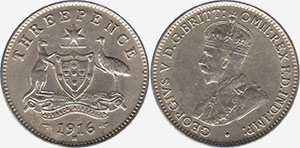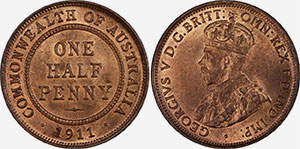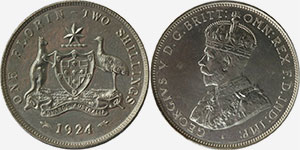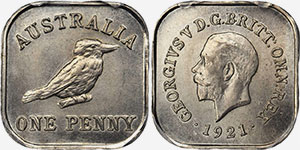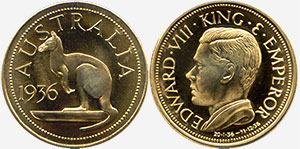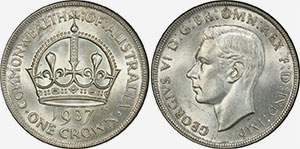The First Commonwealth Issues
By AG | Monday, 15 September 2003
For nine years after federation had welded the colonies into a nation, Australia continued to exclusively use British coinage. Finally, in 1910, the first distinctive Australian Commonwealth coins, struck at the Royal Mint in London, were introduced.
It was a somewhat jinxed start for Australian currency. The range was incomplete as no pennies or halfpennies were struck. The first shipment, consisting exclusively of shillings, arrived on 1st March, 1910. Two months later King Edward VII was dead, long before threepences, sixpences and florins reached Australia to complete the set. Each coin was struck in what is known as .925 fine silver (925 parts silver with 75 parts copper). This mixture had been used in English silver coins for over 1,000 years and is commonly referred to as sterling silver.
The obverse of the 1910 issues depicts a crowned and robed bust of Edward VII facing right. It was designed by the chief designer of the Royal Mint, George William de Saules whose initials 'DES' appear at the base of the bust. The Australian coat of arms, granted by Edward VII in 1908, was the dominant feature of the reverse with the words 'Advance Australia' in a scroll at the feet of an emu and a kangaroo supporting the shield which contained the State Emblems. The design was the work of William Henry James Blakemore, who was also on the staff of the Royal Mint.
The design was to change on each of the coins in 1938 - with one exception. It was retained for the sixpence and its fifty-three-year-old history only came to an end with the introduction of decimal currency in 1966.
The coinage of 1911 opened another chapter in our numismatic history. It saw the introduction of halfpennies and pennies for the first time and a portrait of the new king - Edward's son, George V. The new design was similar in many respects to that of Edward. George was also portrayed crowned and robed although his more youthful looks faced left in the English tradition of alternating the facing direction of each subsequent monarch. This tradition is said to have begun with Charles II who reportedly refused to have his portrait face the same direction as that of Oliver Cromwell. It was his way of 'turning his back' on the commoner who had beheaded his father, Charles I, and led his army into a bloody civil war.
The portrait of George V was executed by Sir Edgar Bertram Mackennal, who was also responsible for the uncrowned likeness of the new monarch which appeared on contemporary English coins. The reverse of the silver coins remained unaltered to those appearing in 1910. This design was to continue until the death of George V, even though a new coat of arms was granted in 1912. This did not appear on any currency until the 1934 issue of notes.
The design for the coat of arms on 1938 coinage contained mistakes. It was intended to update the coat of arms from the original 1906 to the 1912 design which was correctly placed on the 1934 issue of notes. Unfortunately, the wrong coat of arms of South Australia was used - a rising sun and three stalks of wheat instead of the Piping Shrike. The traditional star atop the shield was also wrong; it was replaced with an oversized crown.
The new coat of arms did not appear in its correct form until the release of the 50 cent piece in 1966. The correct shield appears on the current 50 cent pieces, but even this is not strictly correct as the wattle (depicted correctly on the 1938 design) is missing from the 50 cent piece - as it was from the stylised coat of arms on the one dollar note.
The designer of the Edward VII bust, W.H.J. Blakemore, was not accredited with the reverse design of the first pence issued in 1911 until the 1970's. This was due to official policy at the Royal Mint at the time not to identify the work of the staff.
The only noticeable differences between pence and halfpence is the actual part of the design which indicated the denomination. The two scrolls above and below the words 'One Penny' have been deleted to make way for the extra line in the inscription 'One Half Penny'. A small bar has been placed between the word 'Penny' and the date of the halfpenny variety. Both coins were of bronze, - an alloy of copper, zinc and tin.
Between 1910 and 1915, all our coinage was minted in England - either at the Royal Mint or by the Royal Mint's official sub-contractor, Heaton and Sons of Birmingham. Just as the Australian mint engaged the services of the private Stokes and Sons mint in Melbourne to assist with the striking of the 1982 Commonwealth Games $10 issue, so too did the Royal Mint have its 'standby' to ease the pressure. All early Australian silver and bronze issues struck by Heaton carry a small 'H' mintmark under the date.
Home Soil Strikings
The first Commonwealth coins to be struck locally were dated 1916. The new Melbourne mint produced all four silver issues - a total of 11.5 million coins. The bronze issues saw the introduction of a new mintmark (an ' I ' under the word 'Penny') as both the pennies and halfpennies were struck at the Calcutta branch of the Royal Mint from 1916 to 1918 while war raged in Europe.
From 1919 mints in Sydney and Melbourne supplied all Australian needs, although it was not until 1921 that the Sydney mint commenced production of silver coins. The 1921 Sydney shilling is an interesting piece of history. The coin shows a five-pointed star above the date and was designed to mark the drop in the silver content of all future issues due to high prices on the world market. In February, 1920, the price of silver was so high that each sterling silver shilling actually contained 1s 4d worth of silver.
The British Government reacted by cutting the silver content to .500. Australian authorities decided to follow suit and the star shilling was thus prepared. By the time the coin went into production, the price of silver had dropped and the idea was abandoned. The debasement of the silver content was inevitable although twenty-five years were to pass before action was taken.
The Kookaburra Trials
Coin issuing authorities, both now and in the past, consult with coin vending machine manufacturers over the suitability of new coin issues. The mechanical restrictions imposed by coin vending machines in the early decades of the 20th century effectively killed-off a revolutionary idea to replace the heavy round pennies and halfpennies in the early 1920's.
The project is believed to have been the 'brainchild' of the then Treasurer, Mr Watt, who suggested the kookaburra design. Struck in lighter, hardwearing cupro-nickel, the coins were to be square in shape to avoid confusion with sixpenny and threepenny pieces. This proved to be their undoing as coin vending machine operators successfully argued that the coins were impractical by demonstrating just how easily they jammed in the coin acceptor mechanism. The harder nickel alloy proved difficult to work with in striking the coins and there was a greater cost in importing nickel compared to the cost of locally produced metals.
Between 1919 and 1921, several hundred trial coins were distributed to officers of the Treasury, Parliamentarians and selected members of the public to guage reaction. The coins were struck at the Melbourne and London mints with the task of designing the coins being shared by Stokes and Son, Sir Bertram Mackennal (the London issues) and Douglas Richardson.
All but one design shows King George V without his familiar crown. All the reverses show a kookaburra perched on a branch. Different designs can be distinguished by the length of the branch and its relationship to the wording 'One Penny' or 'Half Penny'. On some of the two-line designs (stating the denomination) the branch appears to be hovering over the 'H' of 'Half' or the 'O' of 'One'. On others, the branch appears alongside the wording. Other designs have the words of the denomination on the one line. The kookaburra changes from design to design. On some he appears to be pitifully undernourished, while on others he is quite plump.
The square penny was a contentious issue at the time, with a huge volume of correspondence occuring between the Treasury and the Royal Mint over the acceptability of using an uncrowned portrait of the King. The mint eventually experimented with a crowned portrait in 1920 (Type 10). Despite the controversy, the King did approve the uncrowned portrait and by February, 1921, the Royal Mint had prepared and despatched master dies to Melbourne.
However, with the resignation of Watt as Treasurer, the incoming Minister showed little interest in continuing the project. Consequently, the Treasury did nothing to further the necessary Government regulations to authorise the mint to proceed. The Kookaburra pattern series ended, unissued, in 1921.
The Uncrowned King
A major change in Australia's coinage followed the death of George V in 1936. It was decided to introduce all new designs for the reverse of the circulating coins with the exception of the sixpence. Originally the new coins were scheduled to coincide with the crowning of Edward VIII. Edward's portrait had been appearing on the watermark of our notes since the Legal Tender issues of 1933, while he was still the Prince of Wales.
A number of countries managed to release issues of Edward VIII in 1936, although Australia had earmarked 1937 to release the all-new coins. Reverse patterns, dated 1937, were prepared but work on the obverse ended abruptly on 11th December, 1936 when the king abdicated. No official coins bearing the portrait of Edward VIII were issued in Australia, although there has been an unofficial crown-sized coin produced especially for collectors since then.
The Australian version of this coin (which was also issued in a number of other countries) shows Edward VIII on the obverse and a squatting kangaroo on the reverse. The portrait on this unofficial coin shows something of the character of Edward VIII in getting his own way - the king is facing left - breaking from the tradition of each new monarch facing a different way. Apparently Edward felt designs of him facing right were not flattering. This objection was the most probable cause of delays for a number of countries which did not issue coins of his reign.
Thomas Humphrey Paget was quickly commissioned to produce the obverse design of Edward's younger brother who was destined to become George VI. A number of uniface pattern coins of 1937 were produced and also a few complete coins showning the new likeness of George VI. These coins are extremely rare and fetch high prices at auction.
The Crown - Casey's Cartwheel
One significant coin from these confusing times did reach circulation. The 1937 crown was especially struck to commemorate the coronation of George VI.
It's colloquial or slang name, 'Casey's Cartwheel', was an irreverent dig at the Treasurer of the time, R.G (later Lord) Casey, who proposed the coin. The short history of the Australian crown is a sad and confusing one. Sad, because it was so unpopular. Confusing, because it was originally designed as a one-off commemorative but lost it's significance when issued again in 1938. Intended to celebrate the coronation of George VI after that unfortunate episode concerning his elder brother, that should have been the end of it.
About the only people who liked this huge coin were the same group in the community who liked the 'cartwheel' coins of a century and a third earlier - the tailors and handbad repairers. It was the size of the coin which saw it's demise during the second year of its issue. Since few circulated and many would have been kept as souvenirs, it could be assumed that the crown is fairly common. However, they are quite scarce, particularly the 1938 variety. It appears that even though the coins were unpopular with the Australian general public of the late 1930's, they were much more prized by smugglers during the 1960's when the price of silver reached new heights. Many saw their way to the melting pots in Asia because of their high silver content. Not all the melting down was illegal. The story goes that 400,000 were shipped to China around the beginning of the second World War to be restruck as Sun Yat-sen dollars. Whatever the truth, they soon disappeared from circulation and uncirculated pieces of either date are prized possessions among collectors. The reverse was designed by George Kruger-Gray.
King George VI Issues
It was not until 1938 that new Australian coins, showing their new reverses were to appear. The credit for the reverse designs was given to George Edward Kruger who was to become more famous as George Kruger-Gray. He decided to add the maiden name of his wife to that of his own surname following their wedding in 1918.
However, fresh evidence, which only came to light in October, 1982, indicates that Gray only improved on the designs. The evidence comes from a 1937 newspaper report which quoted the Commonwealth treasurer, Mr Casey, as saying 'The originals [of the reverse design] were the work of Mr Douglas S. Annand of Sydney. They have been redrawn and adapted to facilitate die-making for coinage purposes by Mr Kruger-Gray, who does the bulk of coin designing for the Royal Mint'. Gray also designed coins for New Zealand, Fiji and New Guinea as well as countless medallions and other pieces including the Western Australian Centenary Medal of 1929.
It is Gray's initials which appear on the coins and, for this reason, he is quoted in this catalogue as the designer. As it is, Gray would probably not want to be associated with the reverse design of the florin as it contains a number of major flaws.
The coins of George VI, with George facing the same way as his father, was not a break with tradition. It was more correctly an allowance for what might have happened if Australian coins bearing the portrait of Edward VII had been released.
The Latin inscription around the monarch's head went through an interesting change during the reign of George VI. Initially, the design read 'Georgivs VI D:G:BR:OMN:REX:F:D:IND:IMP', which literally speaking was an abbreviation for 'George VI, King of all the Britains, Defender of the Faith, Emperor of India' (seemingly British officials still regarded us 'colonials' as British or simply not worth a few extra FD's or IMP's to give us some acknowledgement. Perhaps there just wasn't room to fit us in).
A change was necessary following the independence of India in 1948. The 'IND:IMP' (Emperor of India) was dropped from all coinage minted from 1949. But again, Australia did not benefit from this timely bit of extra space, as the Royal Mint decided to fill the gap by merely spelling out the 'F:D' (Defender of the Faith) to 'FIDEI DEF'.
It was during the reign of George VI that Australia again had to rely on outside sources to supplement it's currency needs and to again reconsider the silver debasement situation. The first crisis came in 1942 - for more reasons than one. Japan was at our doorstep and the Americans were already here - and spending up big. The well-paid American servicemen literally broke our banks of small change. The Sydney mint had closed in 1926 and the Perth and Melbourne mints could not cope with the quotas required.
The U.S.A. mints at Denver and San Francisco came to the party, churning out over £6 million worth of florins, shillings, sixpences and threepences between 1942 and 1944. These coins carry either the mintmark 'D' or 'S' respectively. Our old standby, India, came to the rescue with the Bombay branch of the Royal Mint striking both pennies and halpennies during 1942 and 1943.
In 1946 the decision to reduce the silver content of all Australian coins was taken. The 1945 issue was the last to contain sterling silver. All future issues were to contain 'q-metal' - a mixture of 500 parts silver, 400 parts copper, 50 parts nickel and 50 parts zinc (per thousand). The high copper content made the coins look yellow.
A short-term solution was to pickle the coins in acid which gave them a slight covering of silver. However, this was only temporary as excessive handling and the results of coin vending and poker machines soon showed up the coin's true colours.
It was boom conditions which required the London mint to come to the rescue again in 1951 by minting extra coins for Australia. These were the heady days when wool was selling for £1 per pound and the new-found affluence again created a small-change shortage. The Royal Mint produced both denominations of pence as well as sixpences and threepences. It created a precedence by putting a mintmark on the coins. This is in the form of a small 'PL'. The 1951 Mint Annual Report stated: 'The same letters were used, as well as others, for the same purpose on coins struck at London during the Roman Occupation'. It was the last time in the pre-decimal series that overseas assistance was required.
Queen Elizabeth II Issues
Queen Elizabeth II first appeared in 1953 on our coinage following the death of her father in 1952. The rather engaging portrait of the young queen was designed by English sculptress, Mrs Mary Gillick, an ageing widow whose design was accepted as she celebrated her seventy-first birthday.
Once again, the legend was revised. Good news for nationalistic Australians was the deletion of 'BR:OMN' (Of All the Britains). Bad news for the defenders of our moral code was the deletion of the letters 'F:D' (Defender of the Faith). In scenes reminiscent of those which greeted Queen Victoria's 'godless' florin of 1849, church leaders decried the new coin. Mint officials were quick to act and the 1954 Royal Visit florin contained the lettering. All other normal circulating denominations carried the full inscription from 1956, except for the halfpenny which corrected the error with the 1959 issue.
The announcement of decimal currency spelt the end of all Commonwealth denominations. The last florins, shillings and sixpences were struck in 1963. Threepences, pennies and halfpennies expired after 1964.

